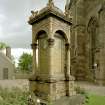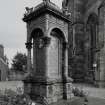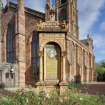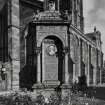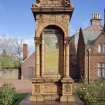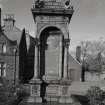Bothwell, Main Street, St Bride's Parish Church, Joanne Baillie Monument
Commemorative Monument (Period Unassigned)
Site Name Bothwell, Main Street, St Bride's Parish Church, Joanne Baillie Monument
Classification Commemorative Monument (Period Unassigned)
Canmore ID 201762
Site Number NS75NW 146
NGR NS 70444 58591
Datum OSGB36 - NGR
Permalink http://canmore.org.uk/site/201762
- Council South Lanarkshire
- Parish Bothwell (Hamilton)
- Former Region Strathclyde
- Former District Hamilton
- Former County Lanarkshire
NMRS REFERENCE
Architect: F. Vincent Hart, 1898-9.
(Undated) information in NMRS.
Square-plan arcaded moulded and cast Italianate monument, raised on polished granite plinth, to the poetess Joanna Baillie, sited to SE of Bothwell Parish Church. Red Doultonware with large, framed mosaic panels to each elevation. Free-standing barleysugar Corinthian column at each angle supporting round arch, standing on advanced square plinths with foliate panels; foliate rectangular panels, slightly recessed, between; cornice between plinth and column. Foliate spandrels; floral and foliate frieze below cornice. Ogee roof with Doultonware blocked tiles and seated cherub at each angle; tall foliate finial. PANELS: roundel with inscription and foliate border below to each elevation depicting portrait of Joanna Baillie, Bothwell Castle, 2 cherubs and fruit trees.
Interest in terracotta peaked in 1886 and a 'rash of terracotta' broke out along high streets and in public places, reflecting a new mood of openness in architectural design, an enthusiasm for new materials and a great sense of civic pride. Producers of terracotta in Scotland numbered only one, being Ferguson, Miller & Co, Heathfield, Strathclyde who produced 'large vases and fountains in the 1850s'. It seems more likely that the Baillie monument was ordered from Doulton & Co, London (or from their works in Rowley Regis, opened in 1889) and assembled on site.
Joanna Baillie was born in the manse behind the church on 11th September 1762 and was the daughter of the minister of St. Brides; she was later to become a friend of Sir Walter Scott. Her father having died in 1776, Joanna and the family moved to London; Joanna spent the rest of her life in Hampstead where she is buried. Here she was to gain notoriety as a poet and a playwright, often writing in her native lowland Scots dialect, her verse "Family Legend" being one of her best known works. The mosaic panels are Venetian, and were manufactured by the Murano Glass Company. The depiction of Joanna is copied from a painting by Masquerier. Likewise, the image of Bothwell Castle with the Clyde at its base is taken from the painting by Horatio McCulloch. (Historic Scotland)












